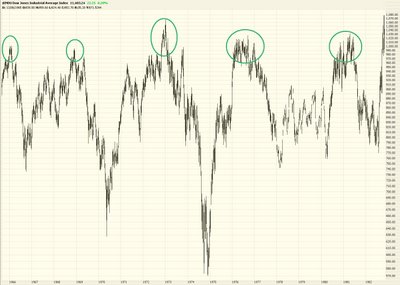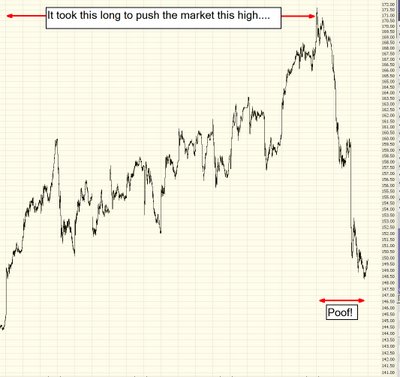Waiting for History to Repeat Itself
Today was pretty much exactly the kind of day I expected after two big down days on Thursday and Friday: that is, an initial descent, some gnashing of teeth while the market tried to figure out what to do with itself, and then finally an ascent on the part of the Dow 30. The major financial sites predictably responded with the swift "recovery" of the market.
I am expecting this recovery to continue, but not for long. Maybe another day. Or two. Or more. But what we must have (if you're a bear) is for this recovery to poop out and for the market to not exceed the highs it made May 10 and to fall lower than the lowers made April 17. This has got to happen or else we will simply be in the process of the market resuming its bullish ways.
Let me make this simplistic (but largely true) observation. In a market which is generally bullish, the bears suffer as follows, more or less:
(a) The market goes up, and the bears short the market during the rise, losing money on the way
(b) The market finally stops rising and starts to fall, and it falls beneath the levels where the bears shorted it. The bears get excited at their newfound profits and start shorting more, eager to create more gains.
(c) The market stops falling and starts to strengthen again. It starts pushing upward, erasing the gains the bears had enjoyed (particularly the most recently entered positions).
(d) The market pushes past the point noted in (b) and creates more severe losses for the bears who help push the market even higher by covering their shorts
(e) As the market gets overbought, the bears resume the cycle established in (a)
So this is a series of "higher highs and higher lows" that destroy bear equity. This has been the cycle, in a broad sense, from October 2002 to the present, a period approaching four years.
Now, at some point (and only God knows when), this pattern stops and the market begins making a series of lower highs and lower lows. In this scenario, it's more like this for the bears:
(a) The market goes up, and the bears short the market during the rise, losing money on the way
(b) The market finally stops rising and starts to fall, and it falls beneath the levels where the bears shorted it. The bears get excited at their newfound profits and start shorting more, eager to create more gains.
(c) The market continues falling, generating still more profits for the bears. The wiser among them wait for the market to become temporarily oversold and cover their positions.
(d) The market stabilizes at its newfound low price and starts to head upward, giving the bulls hope that the selling is over. But the market does not recover to its prior high. Instead, it "poops out" and creates simply a partial retracement.
(e) As the market gets overbought, the bears resume the cycle established in (a)
Now, we're sort of at point "c" right now, and it's absolutely impossible to know for sure what's going to happen next. I do think the strength will continue, but I don't know for how long, nor do I know is that strength will create new highs or not. If I did know those things, I'd be writing this blog from one of a large number of private island fortresses.
The kind of market I think we're in now is reminiscent of the one shown below - from 1966 to 1982. During that very long period, there was a fixation on "Dow 1,000". As you can see, the market hit that point again and again, only to fall from it each time. These days, the fixation is more oriented toward making a new lifetime high on the Dow. We got extremely close on May 10, but I suspect we're in the throes of what could be another major selloff. Whether or not the Dow has enough gas in it to cross the finish line or not remains to be seen. But compare this graph:

......with the more recent Dow. As you can see, the possibility that we're in the first few years of an incredibly length range-bound market is clear.

The NASDAQ 100, which has been quite weak lately, fell through an important support level today. Once the markets do resume their weakness, I imagine the NDX will be especially weak. This support level was quite important, and now it's gone.

Part of the reason for the market's weakness today was that recent hyperbolic markets (Gold, Silver, Crude Oil, Copper, etc.) got blasted. What's great about being a bear in any market is that drops in price usually come much faster than rises. Take a look at this chart - it took just over a couple of days to erase the gains which took weeks to establish in the first place.

I think if you'll look back over last week's recommendations, you'll see virtually all winners. At this point, I've scaled back quite a bit, as I'd prefer to re-enter positions at better prices than these, particular in the energy markets. See you tomorrow, everyone!

1 comment:
Wow, Tim, I was thinking more of a micro-bear market, I guess, really, just a consolidation period. You are thinking of a full blown out bear one?? It will be interesting to see what happens.
Post a Comment